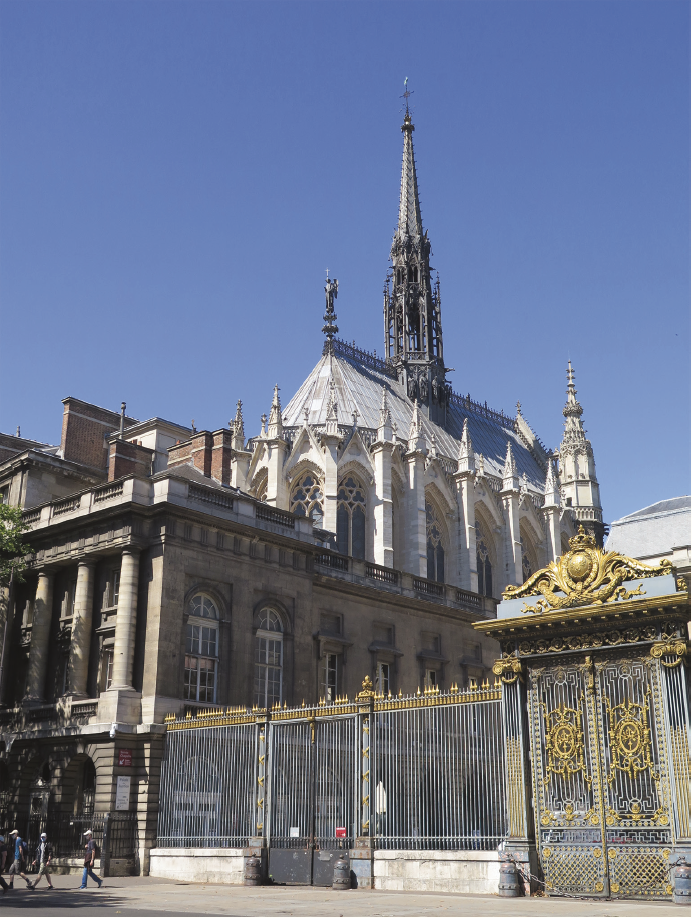by Susan Cahill
Throne and Altar, Altar and Throne. The two go together in pre-Revolution France as intimately as any two members of a royal family.
Before the Revolution, popular religious faith was a mix of traditional beliefs in a triune God (the trinity): God the Father, God the Son, and God the Holy Spirit, each glorified within a colorful and paradoxical context of myths, superstition, and miracles.
The houses (later churches) where the people worshiped their God had a main altar facing the Rising Sun of the East where ordained priests celebrated the commemorative sacrament of the Eucharist. These churches and cathedrals were the dream world of the Christian Middle Ages. The details of stone, colored glass, marble, gold, and wood, each sculpted into a fantastic imagery of animals, plants, devils, and saints were their gifts to the Virgin Mother and God the Father. The faithful loved these sanctuaries of beauty, the colored glass of Notre Dame and Sainte Chapelle, Saint-Denis and Saint Germain l’Auxerrois, the marble statuary of Saint Germain des Pres, Saint Joseph des Carmes, and Saint Eustache; the carved woodwork of Saint Gervais. On Sunday mornings, a day of worship, the wild church bells rang out throughout Paris. Processions in honor of this saint or that martyr added to the enactment of Christian joy.
The French Revolution (1789 – 1795) marked a radical rejection of Throne and Altar. Following the murders in 1793 of King Louis XVI and his Queen, Marie Antoinette, their thrones disappeared and the royal altars were reduced to marble slabs, stripped bare of all ornaments and sacramentals. All this stripping, emptying, and destruction was called de-Christianization. No more church bells on Sunday mornings in Paris, no more Sundays. The “Terror” (1793 – 1794) was the high point of de-Christianization. Maximilien-Francois de Robespierre ruled as Father of the Terror who was himself anti-clerical but terrified of atheism, of France turning against religion and embracing…nothing.
Robespierre dressed a nameless young woman in red, white, and blue chiffon (the colors of the French flag), named her the Goddess of Reason, and installed her atop the stripped altar of Notre Dame. Other girls in red, white, and blue danced around the nave to ballet music. Robespierre, who had a great following in Paris, got rid of holy days, the veneration of the saints; he orchestrated the mutilation of the saints’ images and the incineration of their relics. Crucifixes disappeared. The feasts of Christmas, Easter, and Sunday mornings were canceled.
It was all very politically correct. Abstract. Vague. Stupid. It didn’t take. France remained, for the most part, Catholic, though the children’s schools became secular schools, without the services of nuns and priests or the mention of dogma. (The Revolution exiled 30,000 priests to foreign ports or French Guiana and were said to have executed as many.) Parisians stopped attending Sunday mass partly because the sermons now given by politicians were so deadly boring. Church music provided no relief. The magnificent cathedral choirs, parish choirs, and organs in Saint Sulpice and Saint Severin, among others, went silent. As a result, the Church, originally supportive of some of the changes introduced by the Revolution, turned against it. For the next hundred years, the Church lived in a state of counter-revolutionary hatred.
Robespierre and his disciples—the sans-culottes—were as practical as they were ideological. Altar linens from Sainte Chapelle were made into shirts for soldiers. Church books were sold to grocers for wrapping paper; Sainte Chapelle became a storage granary, Val-de-Grace a military hospital, and the church of Sainte-Genevieve the “Pantheon for Great Men.”
Fueling the feverish anti-clericalism of the Revolution was the recognition of the fabulous wealth of the Church and its attendant corruption. It was the largest landowner in Paris. It also owned most of the city’s jewels, art, silver, gold, and money. The churches and monasteries, as well as individual monks and priests were forced, by threat of the guillotine, to give it up as well as to sign the New Constitution that rejected the rule of the Pope.
The guillotine and environs—or the stabbing mutilations inside and at the entrance to churches–reeked of blood and corpses. The cobblestones outside the Church of St. Joseph des Carmes are said to bear to this day the bloodstains from the murders of priests on the days of the September Massacres.
Paris, finally, had more sense than its de-christianizing revolutionaries or the violence of Bonaparte. With a Bourbon King (Louis XVIII) back on the throne in the early nineteenth century, the altar also re-appeared. Louis built some new churches, re-baptized others, and made Sainte-Genevieve a church again. His work was called “a religious revival.” But, in the words of Colin Jones’s Paris: The Biography of a City, Louis Philippe rejected “anything which smacked of the old union of “Throne and Altar.” That was gone for good.
Susan Cahill has published several travel books on France, Italy, and Ireland, including Hidden Gardens of Paris and The Streets of Paris. She is the editor of the bestselling Women and Fiction series and author of the novel Earth Angels. She spends a few months in Paris every year.



